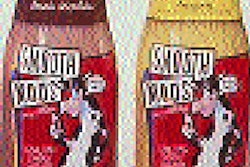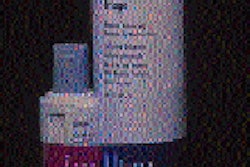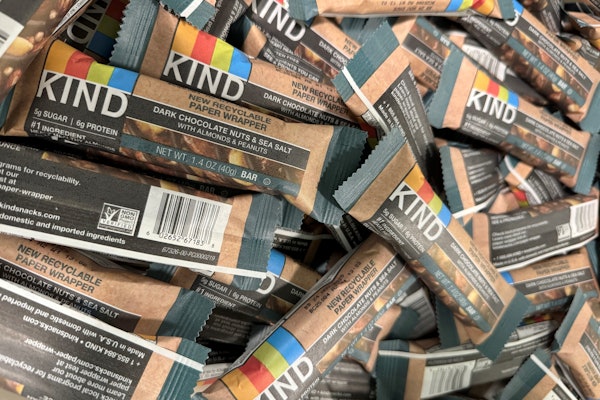The labels on the cans identified the product as Similac, but the powder inside was chalky white - not the creamy yellow they had come to associate with the brand. And, inside, instead of the familiar green scoop, there was a clear one. What was going on, they wanted to know. Why did the product look different? Their calls to Ross Products Div., Abbott Laboratories, Columbus, OH, uncovered one of the most recent cases of food product and package counterfeiting. In this case, the counterfeiters set up shop in Southern California, purchased off-spec formula, packed it into readily available stock cans, then printed and applied phony Similac labels to the cans. The deceit was clever enough to go undetected on at least 4ꯠ cans of counterfeit product purchased and put on the shelf for sale in about 50 Safeway supermarkets in the Sacramento and San Francisco Bay area. In another case that got little notice outside of Northeast Ohio, law enforcement agents last year seized a quantity of bogus Coca-Cola in bottles with counterfeit labels only the most discerning could detect from "the real thing." The Similac and Coke cases make it clear that package counterfeiting is a growing problem and one no longer limited to the computer software, cosmetic, pharmaceutical, designer goods and music industries. With the advent of sophisticated scanning, graphics and desktop publishing software, counterfeiters need no longer be skilled artisans or plate makers. And, because of the relatively low cost of desktop publishing technology, counterfeiters are now looking to knock off products that retail for as little as two dollars. In fact, the British watchdog agency, Label and Tag Security International, reports that product counterfeiting last year accounted for about $80 billion in world trade - about five percent of the total! Three Labeling solutions: The field of security labeling is opening up for packagers looking to stop counterfeiting and assure consumers that they're getting the products they're paying for. Naturally, packagers with packages on counterfeiters' copy lists would rather not tell the bad guys what they're doing about the problem. But here are three labeling approaches they are-or soon will be-using. PharmaGuard(TM): The problem of counterfeiting prescription drugs-by replacing legitimate ones with placebos or pills that are beyond their expiration dates-is what PharmaGuard labels are all about. Developed and marketed by Engraph Label Group's Patton Div. (Moorestown, NJ), PharmaGuard labels are being used on high-density bulk prescription pharmaceutical bottles distributed to pharmacists. The bottles look like they are labeled with conventional ethical drug labels and overwrapped with full-body tamper-evident shrink sleeves. But, when the shrink sleeve is removed, it pulls off a portion of the label underneath. How much of the label is removed can be controlled to render label copy either totally or partially illegible to indicate that the bottle has been opened. Microtaggants(TM): Microscopic product codes that can be blended into label inks, coatings, resins or adhesives-or incorporated into label papers themselves-are a considerably higher-tech response to package counterfeiting. Tiny polymeric particles incorporating the microscopic codes are called Microtaggants. Initially developed as additives for explosives that could be used to identify manufacturers, taggants are now being tailored by Microtrace, Inc. (Minneapolis, MN) for a variety of other applications including the creation of anti-counterfeiting labels. Averaging only 75 microns in diameter, Microtaggants are invisible to the naked eye. Under a 100x microscope they look like irregularly shaped polymer flakes composed of up to 10 different layers, each a different color. Each colored layer corresponds to a digit between 0 and 9 and can be read as a numeric code. Color (and therefore number) sequences can be varied. No two Microtaggant codes are the same. And, with the incorporation of "fluorescent response" or magnetic identifiers on the surface of the flakes, the number of possible codes is almost infinite. In a proprietary process about which it is sharing few details, Microtrace produces the encoded polymer flakes and processes them into a fine powder that resembles graphite. For "fingerprinting" products and packages, Microtaggants keep their encrypted colors intact at temperatures of over 600° F. Cost, depending on the specific packaging application, ranges from a fraction of a cent up to 2¢ per package. HEART(TM): A.D. Tech, Inc. (Taunton, MA) has applied for a patent on an anti-counterfeiting label known as the Holographic Electronic Authenticity Recognition Tag (HEART, for short). At its core, this concept combines two technologies to foil counterfeiters: 1. A pattern metallized hologram. Simple holograms were once good enough to stymie counterfeiters. No more. Sales of holographic equipment are said to be soaring in the Far East. It's thought that many of those units are ending up in the skilled hands of computer software and CD pirates. A.D. Tech figures Pattern Metallization Printing (PMP) of legitimate product hologram labels will set them apart from the fraudulent. 2. Radio-frequency (RF) antennas. Metallization patterns can be created to act as RF antennas or resonators when activated by low-energy RF wands. Resonance frequencies can be tailored to be product or market specific. Market-specific resonating holograms could be used to determine if products manufactured for one market were being diverted. Counterfeiters succeed because consumers traditionally have given packages no more than a glance of recognition in moving products from the store shelf to their shopping carts. But, in the wake of high-profile cases of counterfeiting, consumers will increasingly be looking for the security and product assurance offered by smart labels.

























